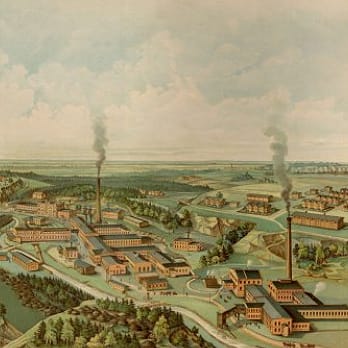ON THE INDUSTRIAL HISTORY OF LATVIA
Latvia’s industrialisation was quite similar to Estonia’s: in the 19th century, both countries were under the rule of the Russian czars, and both lacked classical raw materials such as coal and iron ore. But the abolition of serfdom in the Latvian regions of Livonia and Courland at the start of the century freed up an enormous labour force, and the first factories emerged in the cities. In Riga in particular, textile, wood, metal-working and tobacco-processing enterprises flourished. Railroad construction triggered a further round of industrialisation. Starting in 1860, trains on the line from St. Petersburg and Warsaw stopped in Daugavpils, with Riga added in 1861. In the following years, the Russo-Balt Wagon Factory and machinery works were founded in the suburb Bolderai. Once the rail links to the breadbaskets of southern Russia and the Ukraine were completed, grain trading triggered a massive boom in the Port of Riga.
The coastal cities of Ventspils – with a tradition of shipbuilding dating back to the 17th century– and Liepaja also expanded their shipyards. In 1899, the first Latvian car was built in the bicycle factory Leutner & Co., and wagon-maker Russo-Balt commenced car manufacturing in 1908. Urbanisation took off rapidly, and the population of Riga quintupled between 1871 and 1913. On the eve of World War I the “Baltic provinces” of Livonia, Courland and Estonia were more industrialised than any other part of the Russian Empire. Yet agriculture remained the most important economic sector – and here as well, Latvia and Estonia achieved the highest productivity in the Empire.
The war left behind great devastation, and beyond that, the withdrawing Russians dismantled a large portion of the factories when Latvia gained independence in 1918. However, the government succeeded in building new industries on the basis of domestic raw materials such as wood and flax. Agricultural productivity was enhanced by a land reform. Like the Danes before them, the farmers successfully specialised in exporting refined animal products such a butter and bacon – also with the aid of farmers’ cooperatives, as in Scandinavia. Among the most important new, technologically advanced enterprises was the State Electrotechnical Factory VEF, which produced primarily radios and telephones and introduced the legendary Minox miniature camera. In 1937, the company Vairogs began manufacturing cars and trucks under licence from Ford.
The German and Russian occupations during World War II delivered another bitter setback. Starting in 1945, the Soviets launched a large-scale reconstruction and industrialisation programme, as Latvia possessed a stock of well-trained workers and an infrastructure that was still relatively intact. As natural resources were lacking, Moscow encouraged labour-intensive industries – and the new rulers also wanted to bind the Baltic more closely with the USSR at the same time through the mass settlement of Russian workers. Particularly in Riga, plant equipment and metalworking operations were founded: in 1947, the company RER began manufacturing electrical drive units for locomotives and street cars, the Riga Diesel Engine Factory went into operation and the enterprise RAF quickly made a name for itself in minibuses. Wood processing, textiles and paper manufacturing also expanded.
In the 1960s the Baltic republics covered a major portion of the Soviet Union’s demand for technical products, from motorcycles to washing machines and even telephone switchboards. With its local champion VEF, Riga became an important location for the electronics industry – not least because such products were in great demand by the military. Latvia now numbered among the most highly industrialised and most prosperous republics in the Soviet Union, yet the standard of living only gradually improved on account of the one-sided expansion of industry, which was associated with a severe shortage of consumer goods, and also neglected to develop the service sector.
Latvia was a union republic of the 'Union of Soviet Socialist Republics (USSR)', which was dissoluted in 1991.
Therefore, for completeness, also read our articles on the industrial history of the other former soviet republics
Armenia
Azerbaijan
Belarus
Estonia
Georgia
Kazakhstan
Lithuania
Moldova
Russia
Ukraine


